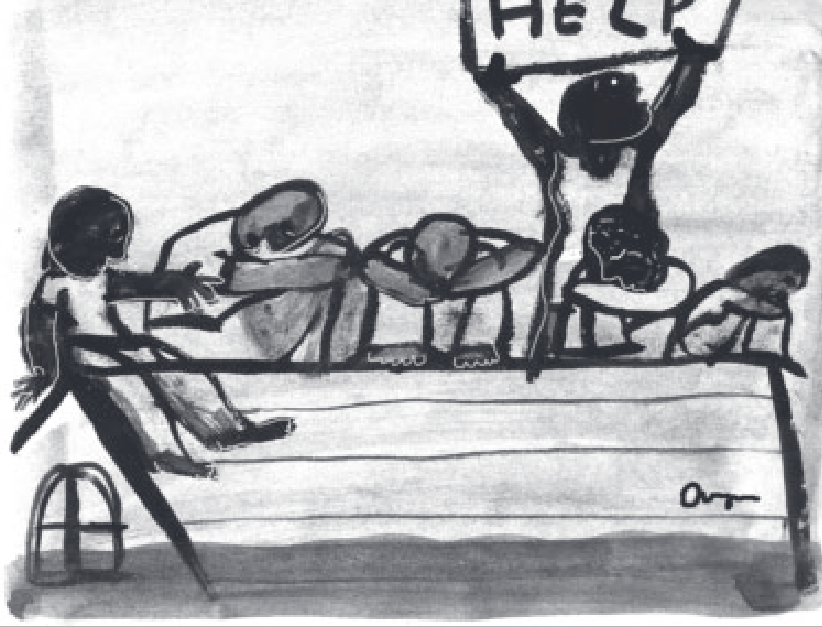Hurricane Katrina hit the coast of southeast Louisiana and southern Mississippi in the early morning of August 29, 2005, as an extremely dangerous Category 4 storm with winds of 135 miles per hour. The storm caused tremendous damage and displaced over one million people from the states of Louisiana and Mississippi.

When it came to helping the victims of the hurricane, President Bush and the people he put in charge of the federal emergency response were disorganized and unprepared. They were slow to rescue the thousands of people trapped in New Orleans and provide assistance to the over one million people displaced by the hurricane.
But when it came to taking advantage of the disaster to reward his friends in big business, Bush and his
—continued on page 6
AFL-CIO and “Change to Win”
Organizing new workers is the core principle of a new labor federation—Change to Win (CTW)—which held its founding convention on September 27, 2005, in St. Louis, Missouri. The organization was formed by a group of seven unions—the Carpenters, the Laborers, the Farm Workers, the Teamsters, Service Employees (SEIU), Textile and Hotel Workers (UNITE HERE), and Food and Commercial Workers (UFCW). The combined membership of the seven unions is about 5.5 million workers. (See the box on page seven to make sense of these alphabet names.)
Four of these unions—the Teamsters, SEIU, UNITE HERE, and UFCW—have ended their affiliation with the AFL-CIO. The Laborers and Farm Workers remain in the AFL-CIO, at least for now. The Carpenters left the AFL-CIO four years earlier in 2001.
The CTW unions chose to form their own federation after they failed to win support for their proposals to dramati-
cally reshape the AFL-CIO to focus more on organizing and to merge smaller unions by industrial sectors. The AFL-CIO leadership agreed with many of the proposed changes but not enough to satisfy the CTW.
The AFL-CIO remains the largest labor federation in the United States with 53 member unions and a combined membership of 9 million unionized workers. However, the four departing unions were some of the largest unions in the AFL-CIO and paid about $30 million of the federation’s $100 million annual operating expenses. The loss of this
income has forced the AFL-CIO to make drastic cuts in staffing and programs.
The AFL-CIO
Since 1955, the US labor movement was represented by a single labor federation when the American Federation of Labor (AFL) and Congress of Industrial Organizations (CIO) merged to form the AFL-CIO. Most of America’s largest unions were affiliated with the AFL-CIO, meaning they paid dues and supported the federation when it didn’t conflict with their own interests. When these was conflict, it wasn’t unusual for unions to quit and rejoin the AFL-CIO when the differences were settled.
There are also an estimated 2,500 unions that are not affiliated with either the AFL-CIO or Change to Win. Most of these are small unions, but there are some large unions such as the National Education Association or United Electrical Workers that chose to remain independent of the AFL-CIO.
As a voluntary association of individual unions, the AFL-CIO has
—continued on page 7
Supreme Court upholds ILWU, dismisses Casumpang appeal
HONOLULU—In an unanimous decision issued on October 18, 2005, the Hawaii Supreme Court ordered the state’s district court to enforce a judgment in favor of the ILWU and against Maui member Nicanor Casumpang, Jr. in the amount of $7,636. The Court also dismissed Casumpang’s appeal that the fine of $7,636 was unreasonable and dismissed Casumpang’s claim that the union owed him 24 days of vacation pay.
In a well reasoned decision, the Supreme Court found that the ILWU Judicial Panel was authorized to impose fines under the union’s constiSupreme Court upholds ILWU, dismisses Casumpang appeal tution and did provide Casumpang with due process. The union gave Casumpang adequate notice of the charges against him. The union gave Casumpang adequate time to prepare a defense. And the union gave Casumpang a full and fair hearing.
The Supreme Court also concluded that the fine imposed on Casumpang of $7,636 was reasonable and supported by substantial evidence. The ILWU Judicial Panel imposed the fine against Casumpang in January 1998 for violating the union’s constitution which prohibited full-time union officials from holding any other paid outside position.
The Hawaii Supreme Court decision is separate from a jury verdict in US District Court against the ILWU which ordered the union to pay $1.24 million in damages to Casumpang. The jury in that trial felt the union had violated Casumpang’s free speech and retaliated against him by imposing a fine and suspending his membership.
The ILWU is appealing that decision and the unusually large monetary damages awarded by the jury. If the union loses its appeal, the award will have to be paid out of the union’s general funds as it is not covered by the union’s liability insurance.
“The Hawaii Supreme Court agreed that the ILWU followed due process and did everything the right way in disciplining Casumpang in 1998,” said ILWU President Fred Galdones. “Unfortunately the jury reached a completely different conclusion. Hopefully, this can be corrected in our appeal.” ◆
